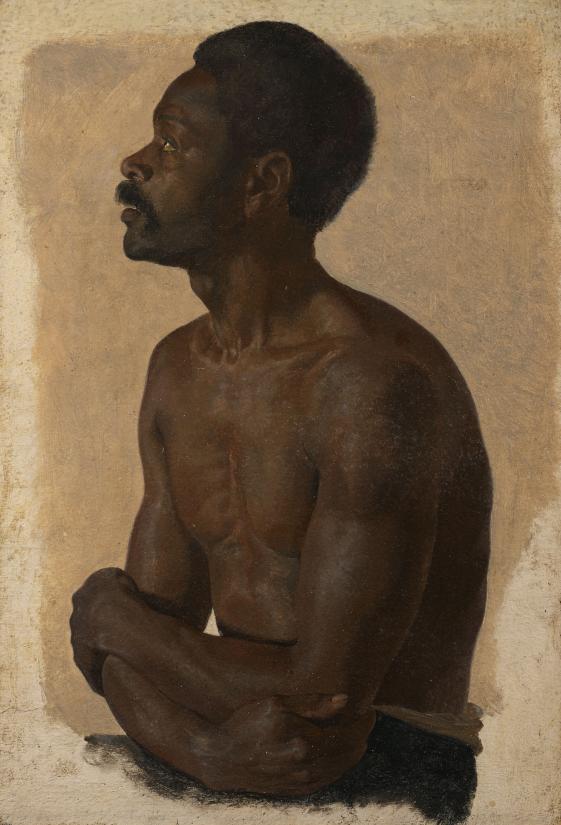Portrait of an African Man was painted by the Danish artist Lorenz Frølich (1820–1908), probably in Paris, while he was a student of the influential French painter Thomas Couture (1815–1879).The painting is a study from Frølich’s life drawing classes, not a finished work intended for the Salon.
Invitation to empathy
At the time, French art typically portrayed Black men with a naked torso to allow the viewer to dwell on the model’s dark skin and striking physique. This fascination is also evident in Frølich’s depiction of his Black model. However, even though the African man portrayed Frølich’s painting is muscular, his expression is not one of strength but rather the opposite: he sits with his arms folded together in front of his body in an almost protective gesture, and his head and gaze are turned up in a humble pose. The contrast between his physique and his posture lend him a vulnerable, almost prayerful expression. An expression known from Christian art.
With this portrayal, Frølich shows empathy with the Black man and invites the viewer to share this feeling. He did so at a time when the topic – the Black model – was closely associated with issues of civil rights and slavery, hotly debated themes in the international community during the mid 19th century. In 1848, three years before Frølich arrived in Paris, slavery had finally been abolished in both the Danish and the French colonies, and formerly enslaved people, now emancipated, were a more frequent sight in the cities.
Why Øregaard?
Portrait of an African Man is relevant to Øregaard Museum because of Frølich’s close ties to the local area and because the history of the Øregaard building is tied to Denmark’s historical role as a colonial power. In Denmark, it was a revolt of enslaved labourers in 1848 on the island of St. Croix in the Danish West Indies that led to the abolition of slavery. At the time, the man who had commissioned Øregaard as his summer residence, Johannes Søbøtker (1777–1854), was vice governor general in the West Indies and thus close to these historic events.
‘Portrait of an African Man ties together several aspects of our work. In particular, Frølich’s painting offers a rare opportunity for conveying perspectives on colonial history, which are also relevant today; including the White man’s gaze on the Black person and how otherwise good intentions may be perceived as Orientalism. Frølich’s painting contributes to our understanding of those topics. It also offers an interesting French angle on Danish Golden Age art and shows what an eminent painter Frølich was,’ says Museum Director Sidsel Maria Søndergaard.
The ‘African Man’ in the context of art history
Portrait of an African Man contains references to a principal work in French art: Théodore Géricault’s (1791–1824) painting The Raft of the Medusa from 1818. The latter painting, which shows a shipwreck that occurred during the French attempt to colonize Senegal, was seen as a liberal criticism of French society. In the painting, one of the key figures is a Black man with a naked torso. He has since been identified as Joseph, who was born in Saint-Domingue, a French Caribbean colony in modern-day Haiti, and who went on to become the most sought-after Black model in Paris. Géricault also did a portrait study of Joseph that depicts the Black man with a sensitive empathy that was unusual for its time. Any artist in Paris during the mid 19th century – including Frølich – will have been familiar with Géricault’s principal piece, which was acquired by the Louvre in 1824. Whether it was in fact Joseph who modelled for Frølich’s painting might be determined by future research. But there is little doubt that Frølich was inspired by Géricault’s work in his portrayal of the African man as a fellow human being.
About Lorenz Frølich
Lorenz Frølich (1820–1908) learned to paint and draw from the best. He took private lessons from Eckersberg, Rørbye and Købke, among others. However, the larger world outside Denmark beckoned, and at the age of just 20 years, he travelled south, to the art schools in Munich and Dresden. After his German sojourn, he spent five years in Rome before eventually settling in Paris. In the French capital, in 1851, he became a student of the prominent painter Thomas Couture, who also taught Édouard Manet. Frølich lived in France for many years, numbering Manet and Degas among his friends. Until he returned to Denmark in 1875, he was highly prolific in drawing, painting, furniture making and decorative projects and also illustrated more than 70 books.
Frølich had one leg in the Golden Age. However, due to his constant drive to develop as an artist, his prolific production and his cosmopolitan openness, he is now considered both a unique artist and a transitional figure in Danish art. He drew inspiration from new European trends and influenced the younger generation of Danish artists.
Portrait of an African Man will be unveiled in the museum’s garden room on 25 October, the 200th anniversary of Frølich’s birth.




